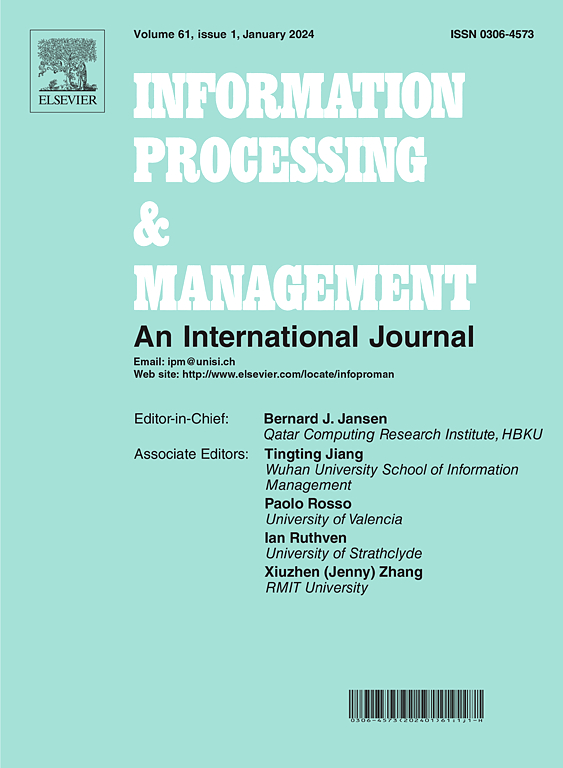基于双曲神经网络的基于零镜头草图的图像检索的域分解和融合
IF 7.4
1区 管理学
Q1 COMPUTER SCIENCE, INFORMATION SYSTEMS
引用次数: 0
摘要
随着基于零镜头草图的图像检索(ZS-SBIR)任务的发展,现有方法仍面临两大挑战:欧几里得空间无法有效表示具有层次结构的数据,导致检索特征缺乏区分度;仅仅依靠视觉信息不足以调整跨领域特征并最大限度地提高其领域泛化能力。为了解决这些问题,本文设计了一种基于双曲神经网络的 ZS-SBIR 框架,该框架考虑了领域分离和融合学习,称为 "DDFUS"。具体来说,我们提出了一种对比性跨模态学习方法,可引导多域视觉表征与双曲空间中的语义表征进行对齐。这种方法确保每个视觉表征都拥有丰富的语义层次结构信息。此外,我们还提出了一种基于双曲神经网络的域解缠方法,该方法采用成对双曲编码器将每个域的表征分解为域不变特征和域特定特征,以减少域之间的信息干扰。此外,我们还设计了一种先进的跨域融合方法,通过重建和生成跨域样本来促进多域信息的融合与交换。它大大增强了域不变特征的表示和泛化能力。综合实验证明,我们的 DDFUS 模型的 mAP@all 在 Sketchy 数据集上超过基于 CNN 的模型 18.99%,在难度更大的 TU-Berlin 数据集上超过 1.93%,在难度更高的 QuickDraw 数据集上超过 11.4%。本文章由计算机程序翻译,如有差异,请以英文原文为准。
Domain disentanglement and fusion based on hyperbolic neural networks for zero-shot sketch-based image retrieval
With the advancement of zero-shot sketch-based image retrieval (ZS-SBIR) tasks, existing methods still encounter two major challenges: Euclidean space fails to effectively represent data with hierarchical structures, leading to non-discriminative retrieval features; relying solely on visual information is insufficient to align cross-domain features and maximize their domain generalization capabilities. To tackle these issues, this paper designs a hyperbolic neural networks based ZS-SBIR framework that considers domain disentanglement and fusion learning, called “DDFUS”. Specifically, we present a contrastive cross-modal learning method that guides the alignment of multi-domain visual representations with semantic representations in the hyperbolic space. This approach ensures that each visual representation possesses rich semantic hierarchical structure information. Furthermore, we propose a domain disentanglement method based on hyperbolic neural networks that employs paired hyperbolic encoders to decompose the representation of each domain into domain-invariant and domain-specific features to reduce information disturbance between domains. Moreover, we design an advanced cross-domain fusion method that promotes the fusion and exchange of multi-domain information through the reconstruction and generation of cross-domain samples. It significantly enhances the representation and generalization capabilities of domain-invariant features. Comprehensive experiments demonstrate that the mAP@all of our DDFUS model surpasses CNN-based models by 18.99 % on the Sketchy dataset, 1.93 % on the more difficult TU-Berlin dataset, and 11.4 % on the more challenging QuickDraw dataset.
求助全文
通过发布文献求助,成功后即可免费获取论文全文。
去求助
来源期刊

Information Processing & Management
工程技术-计算机:信息系统
CiteScore
17.00
自引率
11.60%
发文量
276
审稿时长
39 days
期刊介绍:
Information Processing and Management is dedicated to publishing cutting-edge original research at the convergence of computing and information science. Our scope encompasses theory, methods, and applications across various domains, including advertising, business, health, information science, information technology marketing, and social computing.
We aim to cater to the interests of both primary researchers and practitioners by offering an effective platform for the timely dissemination of advanced and topical issues in this interdisciplinary field. The journal places particular emphasis on original research articles, research survey articles, research method articles, and articles addressing critical applications of research. Join us in advancing knowledge and innovation at the intersection of computing and information science.
 求助内容:
求助内容: 应助结果提醒方式:
应助结果提醒方式:


